英语修辞之移就 Transferred Epithet
- 格式:doc
- 大小:19.50 KB
- 文档页数:4
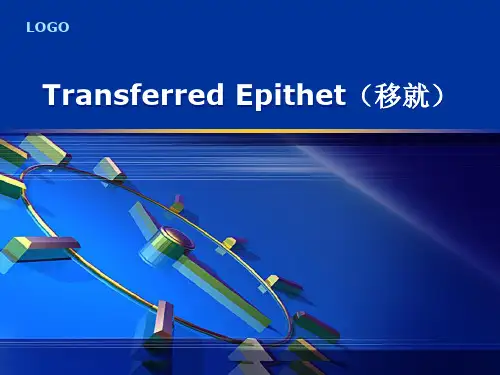
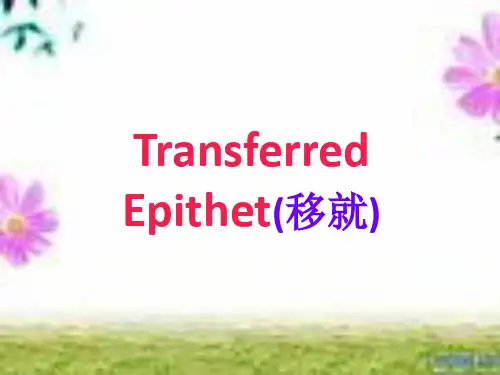
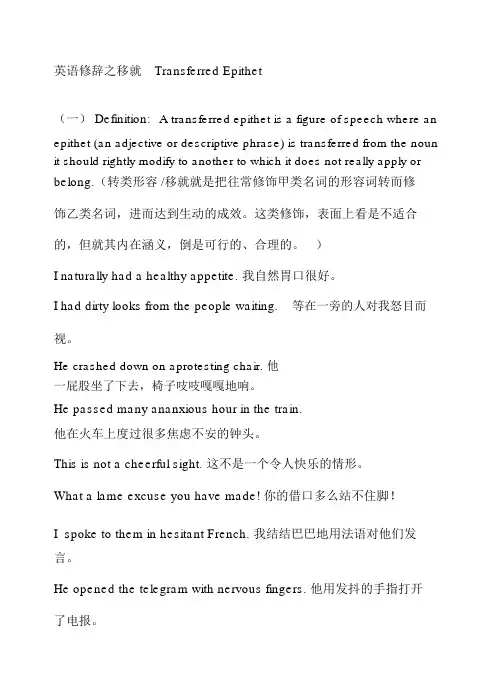
英语修辞之移就Transferred Epithet(一) Definition: A transferred epithet is a figure of speech where anepithet (an adjective or descriptive phrase) is transferred from the noun it should rightly modify to another to which it does not really apply or belong.(转类形容 /移就就是把往常修饰甲类名词的形容词转而修饰乙类名词,进而达到生动的成效。
这类修饰,表面上看是不适合的,但就其内在涵义,倒是可行的、合理的。
)I naturally had a healthy appetite. 我自然胃口很好。
I had dirty looks from the people waiting.等在一旁的人对我怒目而视。
He crashed down on aprotesting chair. 他一屁股坐了下去,椅子吱吱嘎嘎地响。
He passed many ananxious hour in the train.他在火车上度过很多焦虑不安的钟头。
This is not a cheerful sight. 这不是一个令人快乐的情形。
What a lame excuse you have made! 你的借口多么站不住脚!I spoke to them in hesitant French. 我结结巴巴地用法语对他们发言。
He opened the telegram with nervous fingers. 他用发抖的手指打开了电报。
She hastalking eyes. 她有一双会说话的眼睛。
There's somedirty weather knocking about. 坏天气立刻就要来了。
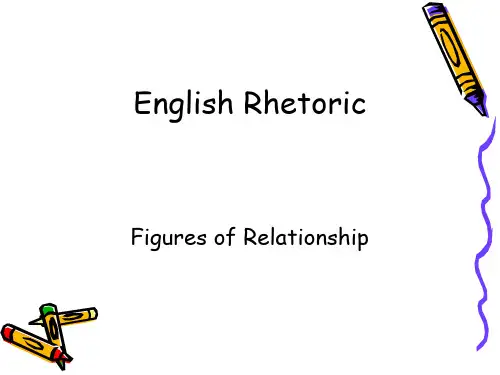
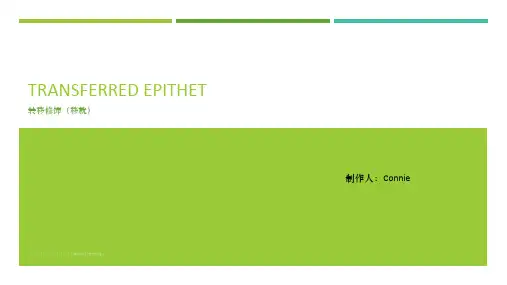
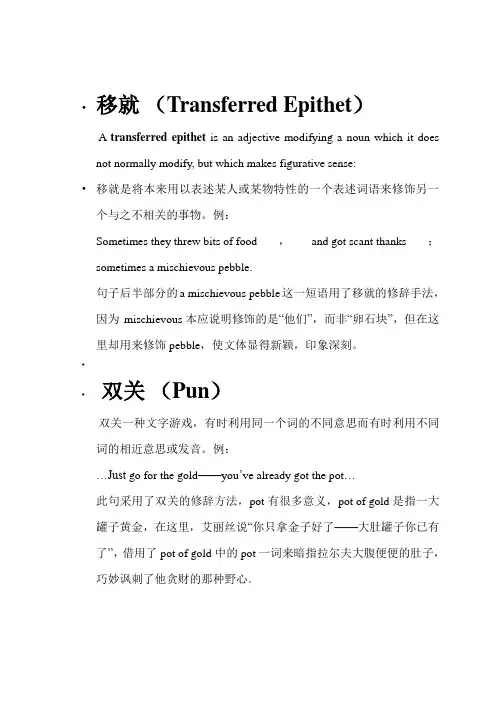
•移就(Transferred Epithet)A transferred epithet is an adjective modifying a noun which it doesnot normally modify, but which makes figurative sense:•移就是将本来用以表述某人或某物特性的一个表述词语来修饰另一个与之不相关的事物。
例:Sometimes they threw bits of food,and got scant thanks;sometimes a mischievous pebble.句子后半部分的a mischievous pebble这一短语用了移就的修辞手法,因为mischievous 本应说明修饰的是“他们”,而非“卵石块”,但在这里却用来修饰pebble,使文体显得新颖,印象深刻。
•(Pun)•双关双关一种文字游戏,有时利用同一个词的不同意思而有时利用不同词的相近意思或发音。
例:…Just go for the gold——you’ve already got the pot…此句采用了双关的修辞方法,pot 有很多意义,pot of gold 是指一大罐子黄金,在这里,艾丽丝说“你只拿金子好了——大肚罐子你已有了”,借用了pot of gold中的pot一词来暗指拉尔夫大腹便便的肚子,巧妙讽刺了他贪财的那种野心。
•反语(Irony)反语是用词语表达与它们的字面意思相异或相反的用法。
它是一种以对比达到幽默效果的修辞方式。
例:You dirty dog,you!First a surprise party-which I abhor …这个例子中存在两个反语即you dirty dog和abhor。
全意是:你这个坏小子,真有你的!先是出其不意地搞一个宴会——这我可不喜欢……句中第一个反语you dirty boy通常用作侮辱性语言,但此处确相反,是对对方的一种昵称,言语中透露出喜爱的意味;abhor原意是“憎恶”,用在此处医生激动不已的心情及其感谢露与其表,不言而喻。
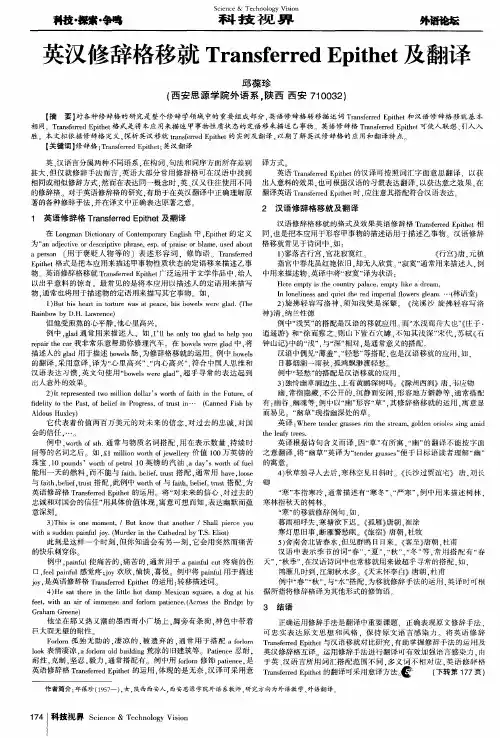
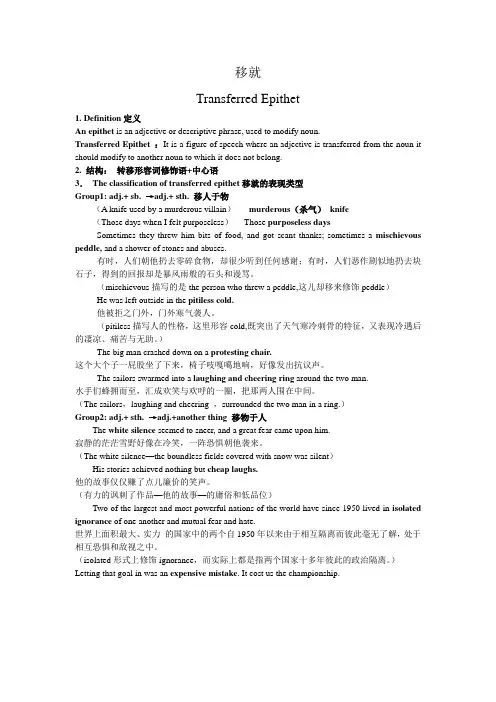
移就Transferred Epithet1. Definition定义An epithet is an adjective or descriptive phrase, used to modify noun.Transferred Epithet :It is a figure of speech where an adjective is transferred from the noun it should modify to another noun to which it does not belong.2. 结构:转移形容词修饰语+中心语3.The classification of transferred epithet移就的表现类型Group1: adj.+ sb. →adj.+ sth. 移人于物(A knife used by a murderous villain)---- murderous(杀气)knife(Those days when I felt purposeless)----Those purposeless daysSometimes they threw him bits of food, and got scant thanks; sometimes a mischievous peddle, and a shower of stones and abuses.有时,人们朝他扔去零碎食物,却很少听到任何感谢;有时,人们恶作剧似地扔去块石子,得到的回报却是暴风雨般的石头和谩骂。
(mischievous描写的是the person who threw a peddle,这儿却移来修饰peddle)He was left outside in the pitiless cold.他被拒之门外,门外寒气袭人。
(pitiless描写人的性格,这里形容cold,既突出了天气寒冷刺骨的特征,又表现冷遇后的凄凉、痛苦与无助。
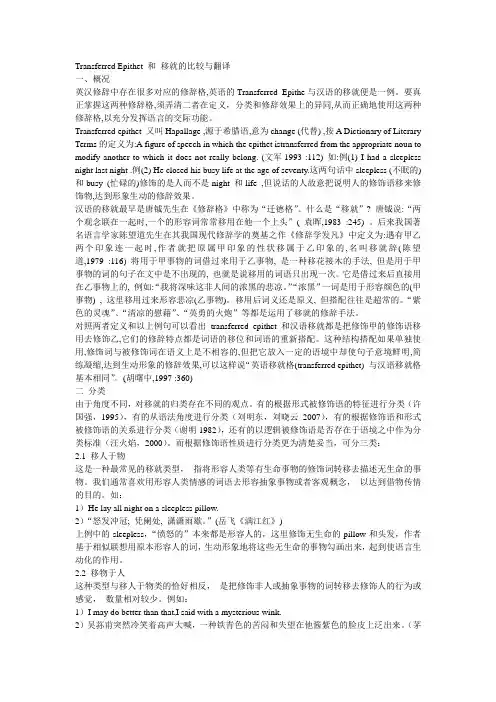
Transferred Epithet 和移就的比较与翻译一、概况英汉修辞中存在很多对应的修辞格,英语的Transferred Epithe与汉语的移就便是一例。
要真正掌握这两种修辞格,须弄清二者在定义,分类和修辞效果上的异同,从而正确地使用这两种修辞格,以充分发挥语言的交际功能。
Transferred epithet 又叫Hapallage ,源于希腊语,意为change (代替) ,按A Dictionary of Literary Terms的定义为:A figure of speech in which the epithet istransferred from the appropriate noun to modify another to which it does not really belong. (文军1993 :112) 如:例(1) I had a sleepless night last night .例(2) He closed his busy life at the age of seventy.这两句话中sleepless (不眠的) 和busy (忙碌的)修饰的是人而不是night 和life ,但说话的人故意把说明人的修饰语移来修饰物,达到形象生动的修辞效果。
汉语的移就最早是唐钺先生在《修辞格》中称为“迁德格”。
什么是“移就”? 唐钺说:“两个观念联在一起时,一个的形容词常常移用在他一个上头”( 袁晖,1983 :245) 。
后来我国著名语言学家陈望道先生在其我国现代修辞学的奠基之作《修辞学发凡》中定义为:遇有甲乙两个印象连一起时,作者就把原属甲印象的性状移属于乙印象的,名叫移就辞(陈望道,1979 :116) 将用于甲事物的词借过来用于乙事物, 是一种移花接木的手法, 但是用于甲事物的词的句子在文中是不出现的, 也就是说移用的词语只出现一次。
它是借过来后直接用在乙事物上的, 例如:“我将深味这非人间的浓黑的悲凉。

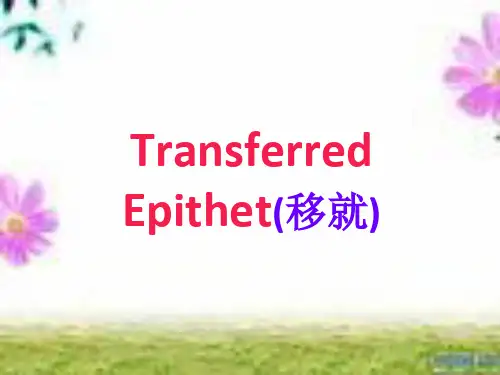
Transferred epithet移就(转移修饰词)A figure of speech in which the epithet is transferred from appropriate noun to modify another to which it does not really belong.把本应该用来描述甲事物状态的定语去形容乙事物,而乙事物却根本不具备这种性质或功能。
On his sick bed he summoned his sons and daughters into his presence.He passed many an anxious hours in the train.I spoke to him in hesitant English.He lives by honest labor.Two high points of color appeared in the paleness of the Duchess of Croydon‟s cheeks.two points of high color (high color 指红晕)1)She has expensive tastes in clothes.她喜欢穿高档衣服。
(语义上修饰clothes的expensive,转移为修饰tastes)2)They prolonged the clasp for the photographer, exchanging smiling words. (exchange words in a smiling way)他们握手时边笑边谈,以此延长握手时间,好让摄影师进行拍照。
3) Mark Twain had to leave the city because of the scathing columns he wrote.4) America has shown us too many desperately worried executive dropping into early graves.在美国,许多走投无路的经理过早跌进了坟墓。
较难英语修辞格Transferred Epithet(移就)It is a figure of speech where an epithet (an adjective or descriptive phrase) is transferred from the noun it should rightly modify(修饰) to another to which it does not really apply or belong.是采用表示性质和特征的形容词或相当于形容词的词来修饰、限定与它根本不同属性的名词。
这种修辞手法能与汉语中的移就基本相似, 移就修辞又称修饰语移置。
例如:1. The doctor's face expressed a kind of doubting admiration.(用"疑惑"修饰限定"钦佩")医生的脸上流露出钦佩而又带有疑惑的神情。
2. I spent sleepless nights on my project.3. He passed many anxious hour in the train.他在火车上度过了许多个焦急不安的时辰。
4. To enjoy this purification even as I enjoy the clean voluptuousness of the w armbreeze on my skin and the cool support of the water. 和风拂过肌肤, 凉水托起全身, 清洁的快感, 沁人心脾。
此时此刻, 我享受着净化灵魂之欢乐。
5. Darrow had whispered throwing a reassuring arm round my shoulder as werewaiting for court to open.Antithesis: (对照)It is the deliberate arrangement of contrasting words or ideas in balanced structural forms to achieve emphasis.例如:1.Speech is silver; silence is golden.2.From them all Mark Twain gained a keen perception of the human race of thedifference between what people claim to be and what they really are.从他们身上,马克·吐温洞察了人类的本性,同时也认识了人们的言行不一。
英语修辞之移就Transferred Epithet
(一)Definition: A transferred epithet is a figure of speech where an epithet (an adjective or descriptive phrase) is transferred from the noun it should rightly modify to another to which it does not really apply or belong.(转类形容/移就就是把通常修饰甲类名词的形容词转而修
饰乙类名词,从而达到生动的效果。
这种修饰,表面上看是不合适
的,但就其内在涵义,却是可行的、合理的。
)
I naturally had a healthy appetite. 我自然胃口很好。
I had dirty looks from the people waiting. 等在一旁的人对我怒目而
视。
He crashed down on a protesting chair.
他一屁股坐了下去,椅子吱吱嘎嘎地响。
He passed many an anxious hour in the train.
他在火车上度过许多焦急不安的钟头。
This is not a cheerful sight. 这不是一个令人愉快的情景。
What a lame excuse you have made! 你的借口多么站不住脚!
I spoke to them in hesitant French. 我结结巴巴地用法语对他们讲
话。
He opened the telegram with nervous fingers. 他用颤抖的手指拆开
了电报。
She has talking eyes. 她有一双会说话的眼睛。
There's some dirty weather knocking about. 坏天气马上就要来了。
Some university graduates thought of themselves as failures simply because they were not offered jobs with fat salaries and generous benefits. 有些大学毕业生仅仅因为没有得到收入丰厚、效益好的工
作而认为自己是个失败者。
Tom closed the car window and sat back in his seat, in hostile silence. 汤姆摇上车窗,坐回到座位上,闷头一言不发。
(二)The classification of transferred epithet
Group1: adj.+ sb. →adj.+ sth.
A knife used by a murderous villain A murderous(杀气)knife Those days when I felt purposeless Those purposeless days
The sailors swarmed into a laughing and cheering ring around the two man.
水手们蜂拥而至,汇成欢笑与欢呼的一圈,把那两人围在中间。
The sailors,laughing and cheering ,surrounded the two man in a ring.
Group2:adj.+ sth. →adj.+another thing
The white silence seemed to sneer, and a great fear came upon him.
寂静的茫茫雪野好像在冷笑,一阵恐惧朝他袭来。
The white silence—the boundless fields covered with snow was silent White fox/ shoes/silk/clouds
His stories achieved nothing but cheap laughs.
Letting that goal in was an expensive mistake. It cost us the championship.
Group3: adj.+ sth. →adj.+ sb.
He is not an easy writer.
The child was noisy in the morning.
Peaceful people are not violent.
(三)The characteristics of Transferred Epithet
1 It relies on the deep structure of the sentence. It is illogical and unreasonable in surface structure but reasonable and just in deep structure.
Eg. The thief made a trembling confession of his wrong doing.
2 There is a close relationship between the transferred epithet and the modified word.
Eg. The big man crashed down on a protesting chair.
3Transferred epithet is suitable for the new context.
Eg. After several acid years. She broke up with the man.
The logic relations between the transferred epithet and modified words. (1)Causal relation(因果)
Puzzled frown 因困惑而皱眉
Delighted smile 因高兴而微笑
Terrified despair 由于恐惧而感到绝望
Thoughtful silence 因沉思而沉默
Ignorant nonsense 由于无知而胡说
(2)Coordinate or parallel relation(平行或并列关系) She sat there with embarrassed delight.
她坐在那里,即尴尬又高兴。
We listened with smiling attention.
我们一边笑一边注意地听着。
(3)disjunctive relation(纯修饰关系)
Laughing eyes 笑眼
Sleepy corner 沉静的角落
A passionate throat 热情的歌喉。